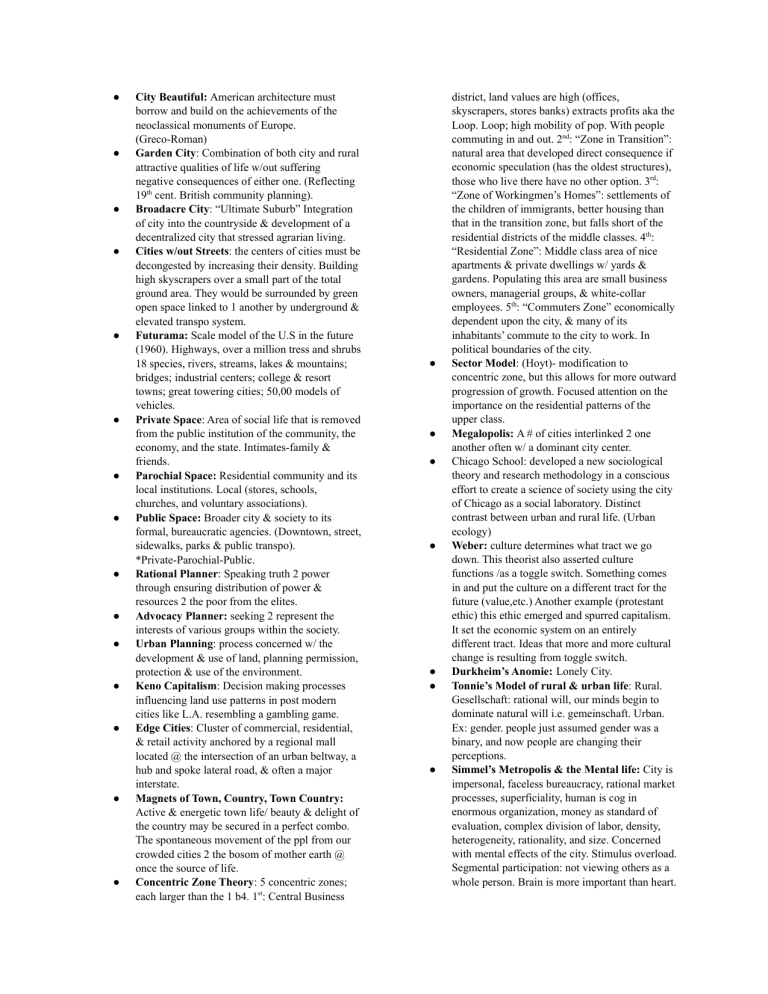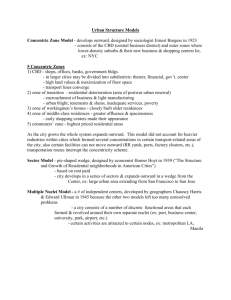
● ● ● ● ● ● ● ● ● ● ● ● ● ● ● City Beautiful: American architecture must borrow and build on the achievements of the neoclassical monuments of Europe. (Greco-Roman) Garden City: Combination of both city and rural attractive qualities of life w/out suffering negative consequences of either one. (Reflecting 19th cent. British community planning). Broadacre City: “Ultimate Suburb” Integration of city into the countryside & development of a decentralized city that stressed agrarian living. Cities w/out Streets: the centers of cities must be decongested by increasing their density. Building high skyscrapers over a small part of the total ground area. They would be surrounded by green open space linked to 1 another by underground & elevated transpo system. Futurama: Scale model of the U.S in the future (1960). Highways, over a million tress and shrubs 18 species, rivers, streams, lakes & mountains; bridges; industrial centers; college & resort towns; great towering cities; 50,00 models of vehicles. Private Space: Area of social life that is removed from the public institution of the community, the economy, and the state. Intimates-family & friends. Parochial Space: Residential community and its local institutions. Local (stores, schools, churches, and voluntary associations). Public Space: Broader city & society to its formal, bureaucratic agencies. (Downtown, street, sidewalks, parks & public transpo). *Private-Parochial-Public. Rational Planner: Speaking truth 2 power through ensuring distribution of power & resources 2 the poor from the elites. Advocacy Planner: seeking 2 represent the interests of various groups within the society. Urban Planning: process concerned w/ the development & use of land, planning permission, protection & use of the environment. Keno Capitalism: Decision making processes influencing land use patterns in post modern cities like L.A. resembling a gambling game. Edge Cities: Cluster of commercial, residential, & retail activity anchored by a regional mall located @ the intersection of an urban beltway, a hub and spoke lateral road, & often a major interstate. Magnets of Town, Country, Town Country: Active & energetic town life/ beauty & delight of the country may be secured in a perfect combo. The spontaneous movement of the ppl from our crowded cities 2 the bosom of mother earth @ once the source of life. Concentric Zone Theory: 5 concentric zones; each larger than the 1 b4. 1st: Central Business ● ● ● ● ● ● ● district, land values are high (offices, skyscrapers, stores banks) extracts profits aka the Loop. Loop; high mobility of pop. With people commuting in and out. 2nd: “Zone in Transition”: natural area that developed direct consequence if economic speculation (has the oldest structures), those who live there have no other option. 3rd: “Zone of Workingmen’s Homes”: settlements of the children of immigrants, better housing than that in the transition zone, but falls short of the residential districts of the middle classes. 4th: “Residential Zone”: Middle class area of nice apartments & private dwellings w/ yards & gardens. Populating this area are small business owners, managerial groups, & white-collar employees. 5th: “Commuters Zone” economically dependent upon the city, & many of its inhabitants’ commute to the city to work. In political boundaries of the city. Sector Model: (Hoyt)- modification to concentric zone, but this allows for more outward progression of growth. Focused attention on the importance on the residential patterns of the upper class. Megalopolis: A # of cities interlinked 2 one another often w/ a dominant city center. Chicago School: developed a new sociological theory and research methodology in a conscious effort to create a science of society using the city of Chicago as a social laboratory. Distinct contrast between urban and rural life. (Urban ecology) Weber: culture determines what tract we go down. This theorist also asserted culture functions /as a toggle switch. Something comes in and put the culture on a different tract for the future (value,etc.) Another example (protestant ethic) this ethic emerged and spurred capitalism. It set the economic system on an entirely different tract. Ideas that more and more cultural change is resulting from toggle switch. Durkheim’s Anomie: Lonely City. Tonnie’s Model of rural & urban life: Rural. Gesellschaft: rational will, our minds begin to dominate natural will i.e. gemeinschaft. Urban. Ex: gender. people just assumed gender was a binary, and now people are changing their perceptions. Simmel’s Metropolis & the Mental life: City is impersonal, faceless bureaucracy, rational market processes, superficiality, human is cog in enormous organization, money as standard of evaluation, complex division of labor, density, heterogeneity, rationality, and size. Concerned with mental effects of the city. Stimulus overload. Segmental participation: not viewing others as a whole person. Brain is more important than heart. ● ● ● ● ● ● ● ● ● ● ● ● ● ● ● Blasé: Unimpressed, Nonchalant, self-protected device to shield an individual from urban life reinforced by money and economy Marx’s economic view of the city: Impetus of social change is technology, all about the economics. all institutions based around economic institutions. David Harvey’s Baltimore: Baltimore’s constant physical transformation is a reflection of the desire for profit & future capital accumulation & the means by which ppl of economic power had the wherewithal 2 build & rebuild the physical environment. Sharon Zukin: Symbolic economy in cities impacts on “social inclusion or exclusion, depending on your pov”. Symbolic economy becomes dependent on the creation of attractions. Urban Ecology: The study of the development and form of community structure in a city in different environmental contexts. 3rd Place: interrupts the regular cycle of urban life. “A stop at Starbucks”. Macro & Micro Sociology: Macrosociology allows observation of large-scale patterns and trends but runs the risk of seeing these trends as abstract entities that exist outside of the individuals who enact them on the ground. Microsociology allows for this on-the-ground analysis but can fail to consider the larger forces that influence individual behavior. Shock City in America: (Chicago) fastest growing city in the U.S/ rapidity of growth. (diversified population). Shock City in England: often when the city has job opportunities that draw people in. Suburb: An area beyond the city boundaries. Exurb: An area between the rural & suburb area. Interdictory Zone: application of modern society technology 2 a variety of suppression & surveillance techniques used for the entire city. Fortified City: Gated Residential developments & shopping malls are fortified & high tech policing methods are employed for the sake of security. Global cities: cities that are strategic sites in the global economy b/c of their concentration of command functions & high-level producer service firms oriented to world market. Zone of Transition: businesses and light manufacturing poverty, degradation + disease, immigrant housing, factory zone. Gans Construction of social organization in the city: size, density, and heterogeneity have a negative impact on some, not all, people. Only affects deprived and ● ● ● ● ● ● ● trapped/downwardly mobile. Puts City dwellers into 5 types. 1. Cosmopolites, 2. Unmarried or childless, 3, Ethnic villagers, 4. Deprived, 5. Trapped/downwardly mobile. Claude Fischer (Subcultural theory): Urbanization, rather than destroying groups, provides a critical mass of persons to allow subcultures to emerge Urbanization strengthens & intensifies subcultural groups. Place matters, but it is the opposite of Wirth, in that people make friends among interest groups, work groups. Privatopia: Walled & gated. Private housing developments governed by a common interest association or homeowner’s association. Heteropolis: Socioeconomic polarization, racism, inequality, homelessness, & social unrest. Homogeneity: people who share similar regional, class, racial backgrounds. 3 Realms of the City (Hunter & Lofland): Private, Parochial & the Public Realm *see 6,7 & 8th bullet points*. Park & Burgess: Concentric Zone theory. View city as a human eco-system, functioning similar to other biological eco-systems. cities grow in concentric circles that have different zones -a model of internal structure of cities in which social groups are arranged. Urban growth machine: Cities can be seen as machines for urban growth, machines that are developed & shaped by a select group of people representing institutions that can best profit from that growth.






